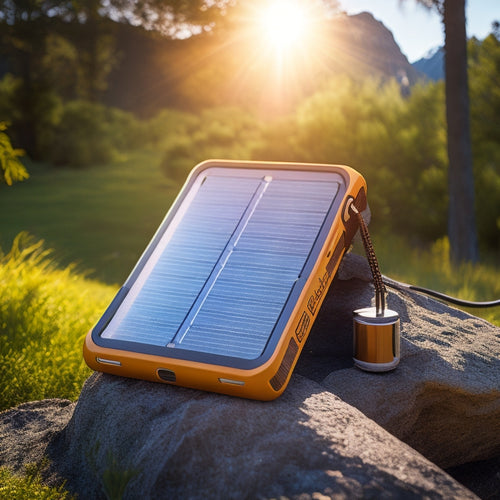
Charging Solar Batteries for Home Energy Freedom
Share
When charging solar batteries for home energy freedom, you'll want to assess your energy needs by tracking consumption patterns, evaluating load management, and conducting a cost analysis. Choose the right battery by considering factors like energy density, lifespan, and compatibility with your solar panel system. Optimize charge cycles to maximize efficiency and lifespan, and regularly monitor battery health indicators like state of charge, voltage, and temperature. By sizing your solar array correctly, you'll generate enough energy to power your home. Now, fine-tune these details to release the full potential of your solar battery system and take the next step towards energy independence.
Overview
- Track energy consumption patterns to understand peak hours and optimize battery charging for home energy freedom.
- Choose the right battery by considering factors like energy density, lifespan, and compatibility with existing solar panel systems.
- Optimize charge cycles to increase efficiency, prolong battery lifespan, and maximize the return on investment.
- Regularly monitor battery health indicators like state of charge, voltage, and temperature to prevent performance issues.
- Size your solar array correctly by considering daily energy generation needs, roof capacity, and local solar irradiance for optimal energy production.
Assessing Your Energy Needs
To achieve home energy freedom, you must first determine your energy requirements. This involves tracking your energy consumption patterns, including peak hours and overall usage. Evaluating your energy needs helps you identify the best solar efficiency and battery capacity required to meet your demands.
You'll need to take into account your load management strategy, ensuring that your system can handle simultaneous appliance usage. A thorough cost analysis will also help you determine the feasibility of your project.
Conducting an energy audit will help you identify inefficiencies and make accurate assumptions about energy usage patterns for better system tailoring. Understanding your energy needs is vital in maximizing your battery lifespan and achieving energy independence.
Choosing the Right Battery
One crucial aspect of achieving home energy freedom is selecting the right solar battery, as it directly impacts your system's performance, efficiency, and overall cost.
You'll want to contemplate lithium options, known for their high energy density and long battery lifespan. Deep cycle batteries, which are essential for storing excess energy, offer an extended lifespan, with some models providing over 5,000 cycles.
Lithium-ion batteries, in particular, offer a lifespan of 15-20 years, making them a popular choice for home energy systems.
When choosing a battery, you should also reflect on factors such as depth of discharge, round-trip efficiency, and compatibility with your solar panel system.
Optimizing Charge Cycles
You've selected the right battery for your home energy system, now it's time to focus on optimizing charge cycles to get the most out of your investment. Optimizing charge cycles is essential to guarantee charge efficiency and cycle longevity. A well-optimized charge cycle can increase your battery's lifespan and reduce the likelihood of premature degradation.
| Charge Cycle Strategy | Charge Efficiency | Cycle Longevity |
|---|---|---|
| Standard Charge Cycle | 80% | 300-500 cycles |
| Optimized Charge Cycle | 90% | 800-1000 cycles |
| Advanced Charge Cycle | 95% | 1500-2000 cycles |
| Customized Charge Cycle | 98% | 2500-3000 cycles |
Monitoring Battery Health
Your solar battery's performance relies heavily on its health, making regular monitoring crucial to identify potential issues before they escalate.
You need to keep a close eye on health indicators like state of charge, voltage, and temperature to guarantee peak performance. Regular monitoring helps you detect anomalies, allowing you to take corrective action before they impact your energy freedom.
Effective battery maintenance involves tracking these indicators, performing routine checks, and making adjustments as needed. Additionally, setting a discharge limit and maintaining the recommended depth of discharge (DOD) range can greatly extend your battery's lifespan.
Sizing Your Solar Array
Three key factors determine the ideal size of your solar array: your energy requirements, available roof space, and local solar irradiance.
You'll need to calculate how much energy you want to generate daily, considering your energy-hungry appliances and devices.
Next, assess your roof's capacity to accommodate solar panels, factoring in obstructions and shading.
Local solar irradiance, or the amount of sunlight your location receives, will also impact your array's size.
When selecting solar panel types, prioritize high-efficiency models to maximize energy production.
System efficiency will also play a role, as it affects how well your array converts sunlight into electricity.
Frequently Asked Questions
Can Solar Batteries Be Charged From the Grid During Power Outages?
You can charge your solar batteries from the grid during power outages, thanks to advanced power management systems that enable seamless grid-tie functionality, allowing you to prioritize battery charging and maintain energy independence.
Are Solar Batteries Compatible With All Types of Solar Panels?
You're probably thinking you need a Ph.D. in solar engineering to guarantee solar batteries are compatible with your panels, but fear not! Most solar batteries are designed to work with various panel types, prioritizing battery efficiency over solar panel compatibility, so you're good to go!
Do Solar Batteries Require Regular Maintenance or Replacement Parts?
You'll need to perform routine checks on your solar batteries to guarantee peak performance, replacing worn-out parts as needed, which can extend their lifespan; follow maintenance tips like monitoring temperature, voltage, and charge cycles to maximize energy storage.
Can I Use a Generator to Charge My Solar Battery System?
You're not limited to the sun's schedule! Yes, you can use a generator to charge your solar battery system, but confirm generator compatibility and optimize charging efficiency to avoid wasting energy and reducing system lifespan.
Are There Any Rebates or Incentives for Installing Solar Batteries?
You'll be thrilled to know that yes, there are incentives for installing solar batteries! You'll qualify for federal incentives and likely state rebates, too, which can greatly offset your upfront costs, giving you a clearer path to energy independence.
Ready to Buy
As you unleash the power of solar energy, your home evolves into a self-sustaining oasis, free from the grid's grip. Your carefully chosen battery, optimized charge cycles, and precisely monitored health converge to create a harmony of efficiency. With your solar array perfectly sized, the sun's rays are captured to fuel your independence. Now, bask in the freedom to live life on your own terms, unshackled from the constraints of traditional energy sources.
Related Posts
-

Fastest Solar Chargers for Emergency Power
When choosing the fastest solar chargers for emergency power, you need to focus on features like rapid charging capab...
-

Top-Rated Home Solar Power Kits for Achieving Energy Independence
Top-rated home solar power kits enable you to achieve energy independence by greatly cutting your energy costs. You c...
-

Cost of Home Solar Battery
You're looking to invest in a home solar battery to reduce your grid reliance, but you're curious about the cost. The...


